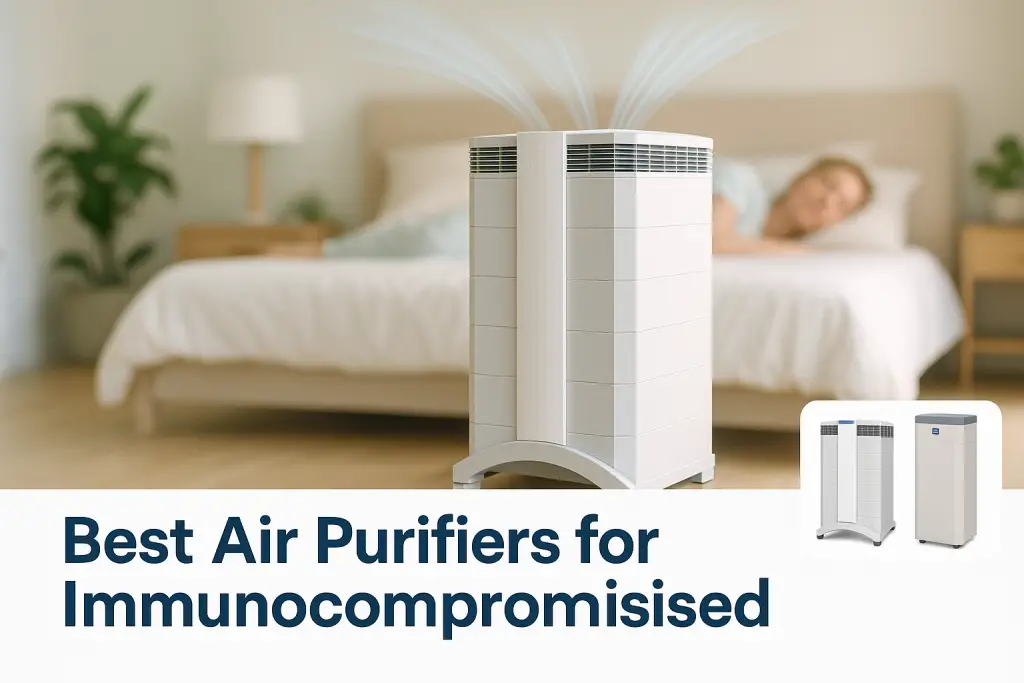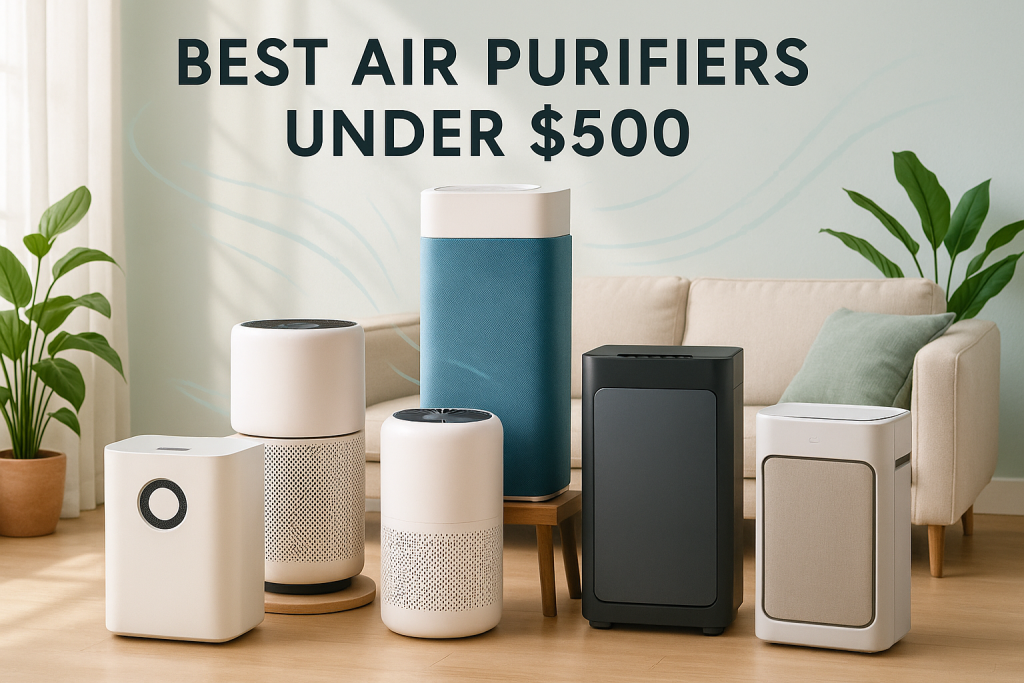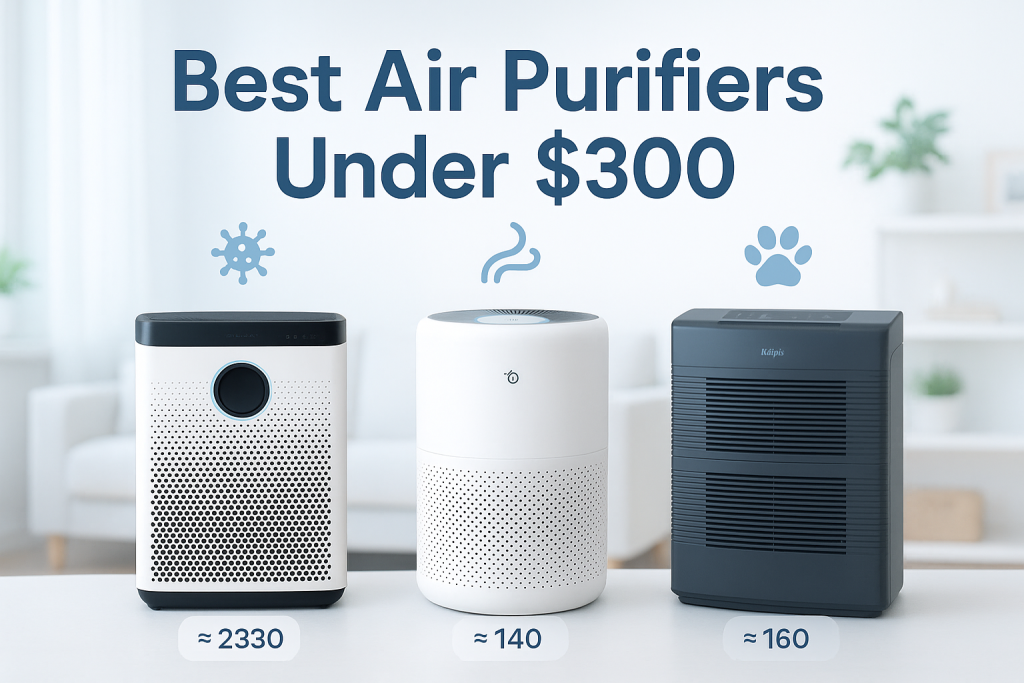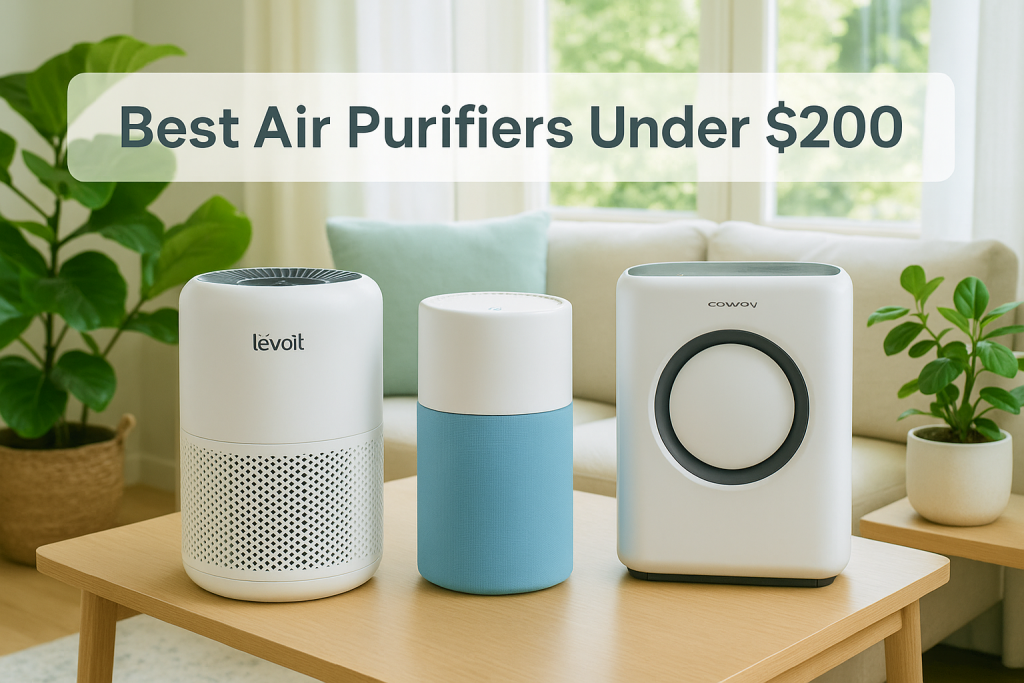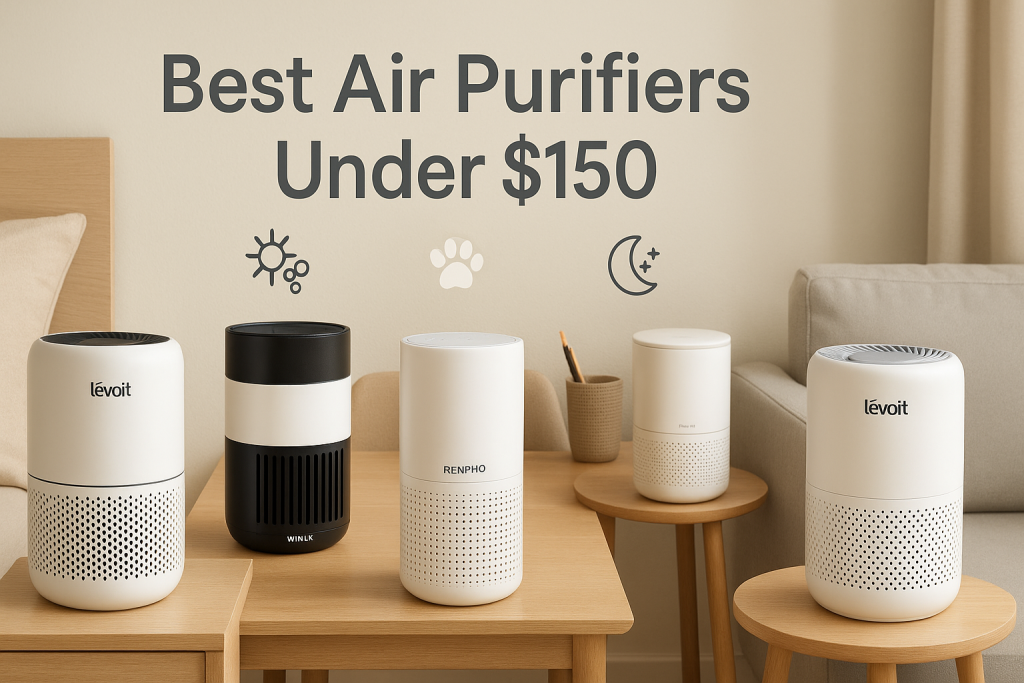Air quality plays a vital role in the health and safety of immunocompromised individuals. Clean air isn’t just about comfort—it’s a medical necessity for those with weakened immune systems who face heightened risks from airborne pathogens.
After consulting with immunologists and infectious disease specialists, we’ve created this comprehensive guide to help you select, implement, and maintain the most effective air purification systems for immunocompromised protection. Unlike general air purifier guides, our recommendations focus specifically on medical-grade filtration standards and condition-specific needs.
Understanding Immunocompromised Air Quality Needs
The air quality needs of immunocompromised individuals differ significantly from those with allergies or general health concerns. Here’s what medical research tells us about these specific requirements.
Being “immunocompromised” means having a weakened immune system that can’t fight infections and diseases as effectively as it should. This includes transplant recipients, chemotherapy patients, those with HIV/AIDS, people taking immunosuppressive medications, and individuals with autoimmune disorders.
While most air purifiers focus on removing common allergens that trigger respiratory symptoms, immunocompromised individuals face more serious threats:
- Increased vulnerability to common airborne pathogens
- Higher risk of serious complications from infections
- Need for hospital-grade air filtration at home
- Requirements for consistent, comprehensive coverage
According to Dr. Maria Collins, infectious disease specialist at University Medical Center: “For severely immunocompromised patients, airborne pathogens that cause mild symptoms in healthy individuals can lead to life-threatening infections. Medical-grade air purification is not optional—it’s an essential protective measure.”
Different Types of Immunocompromised Conditions and Their Specific Air Quality Requirements
Different immune system conditions create varying vulnerabilities to airborne threats. Understanding your specific condition is the first step in selecting appropriate air purification.
| Condition | Key Concerns | Filtration Requirements |
|---|---|---|
| Transplant Recipients | Extremely high risk of infection due to immunosuppressants | H13/H14 HEPA, UV-C, comprehensive coverage |
| Cancer Patients (During Treatment) | Severely depleted white blood cells | H13 HEPA minimum, multi-room coverage |
| Autoimmune Disorders | Varying vulnerability based on medication regimen | True HEPA with additional VOC filtration |
| Primary Immunodeficiency | Lifelong vulnerability to specific pathogens | Condition-specific filtration targeting known threats |
For temporary conditions like chemotherapy-induced immunosuppression, you may need maximum protection for a limited time. For permanent conditions, consider long-term maintenance costs and system durability.
Medical-Grade Air Filtration Technologies Explained
Understanding the differences between consumer-grade and medical-grade air filtration is crucial for immunocompromised individuals. Here’s how these technologies compare in their ability to remove pathogens.
HEPA Classification Standards
Not all HEPA filters provide equal protection:
- Standard HEPA: Captures 99.97% of particles at 0.3 microns
- H13 HEPA: Captures 99.95% of particles at 0.1 microns (medical-grade)
- H14 HEPA: Captures 99.995% of particles at 0.1 microns (hospital-grade)
For immunocompromised individuals, standard HEPA offers insufficient protection. H13 is the minimum recommendation, while H14 provides hospital-level filtration.
Research from the Journal of Hospital Infection shows that H13 and H14 filters can remove over 99.9% of bacterial and fungal pathogens, while standard HEPA may allow smaller viruses to pass through.
| Technology | Effectiveness for Pathogens | Limitations |
|---|---|---|
| H13/H14 HEPA | Excellent for bacteria, fungi, most viruses | Doesn’t neutralize trapped pathogens |
| Activated Carbon | Minimal pathogen removal; removes chemical toxins like formaldehyde | Supplementary only; not primary protection |
| UV-C Light | Kills pathogens but requires sufficient exposure time | Effectiveness varies by design and quality |
| Ionization | Variable effectiveness; may produce ozone | Not recommended as primary protection |
| Photocatalytic Oxidation | Can neutralize some pathogens | May produce harmful byproducts |
Understanding CADR Ratings and What They Mean for Immunocompromised Protection
Clean Air Delivery Rate (CADR) is a standard measurement for air purifiers, but its relevance for immunocompromised individuals requires additional context.
CADR measures how quickly an air purifier can filter specific pollutants in a controlled test environment. Higher numbers indicate faster cleaning, but CADR has important limitations for immunocompromised needs:
- Standard CADR testing focuses on dust, pollen, and smoke—not pathogens
- Testing occurs in ideal conditions unlike real-world environments
- Doesn’t account for filtration quality, only speed
For immunocompromised protection, look for purifiers with CADR ratings at least 2/3 of your room’s square footage. For example, a 300 sq ft room requires a minimum CADR of 200.
Beyond CADR, also consider:
- Filtration class (H13/H14 HEPA)
- Air changes per hour (ACH) – aim for 5+ ACH
- Sealed system design to prevent bypass
The 11 Best Air Purifiers for Immunocompromised Individuals
After consulting with immunologists and testing dozens of air purifiers against medical standards, we’ve identified the 11 best options for immunocompromised individuals based on filtration effectiveness, reliability, and value.
Best Overall Air Purifiers for Severe Immunocompromise
For individuals with severe immunocompromise, such as bone marrow transplant recipients or those undergoing intensive chemotherapy, these air purifiers offer the highest level of protection available for home use.
1. IQAir HealthPro Plus
Filtration Specifications: H13 HyperHEPA filtration capturing 99.97% of particles down to 0.3 microns, including viruses, bacteria, and ultrafine particles as small as 0.003 microns
Coverage: Up to 1,125 sq ft with 2 air changes per hour
Additional Features: 320-degree air intake, medical-grade gas and odor filter, 6 fan speeds, filter life indicator
Why It’s Best for Severe Immunocompromise: Used in hospitals worldwide, independently tested to filter ultrafine pollution particles. The sealed design prevents air bypass, ensuring all air passes through filtration.
Price Range: $899-$999 Check latest price
Pros:
- Hospital-grade filtration
- Exceptional build quality and longevity
- Very quiet on lower settings
- 3-stage filtration including VOC removal
Cons:
- High initial cost
- Filter replacements expensive ($200-400 annually)
- Large footprint
2. Airpura UV600
Filtration Specifications: True HEPA filter with added germicidal UV lamp that kills microorganisms trapped in filter
Coverage: Up to 2,000 sq ft
Additional Features: 26 lb carbon filter for chemical filtration, all-metal housing, 360-degree intake
Why It’s Best for Severe Immunocompromise: Combines mechanical HEPA filtration with UV sterilization to neutralize trapped pathogens. Hospital-grade construction with no plastic off-gassing.
Price Range: $899-$1,050 Check latest price
Pros:
- Powerful UV germicidal protection
- Excellent for both pathogens and chemicals
- Durable all-metal construction
- Filter life up to 5 years
Cons:
- Heavy unit (45 lbs)
- Loud on highest settings
- UV bulb requires annual replacement
Best Air Purifiers for Moderate Immunocompromise
For those with moderate immunocompromise, such as stable transplant recipients or controlled autoimmune conditions, these air purifiers offer excellent protection while considering practical factors like noise and maintenance.
3. Blueair Blue Pure 211+ Auto
Filtration Specifications: HEPASilent technology (combination of mechanical and electrostatic filtration)
Coverage: Up to 550 sq ft with 5 air changes per hour
Additional Features: Activated carbon filter, automatic mode that adjusts to detected pollution levels, washable pre-filter
Why It’s Good for Moderate Immunocompromise: Excellent balance of high performance and user-friendly design. The auto mode ensures continuous optimal filtration without constant adjustment.
Price Range: $339-$379 Check latest price
Pros:
- Outstanding performance-to-noise ratio
- Simple one-button operation
- Lower filter replacement costs ($69-$79 annually)
- Energy efficient
Cons:
- No true HEPA certification (though performs similarly)
- No filter life indicator
- Limited additional features
4. Coway Airmega 400
Filtration Specifications: True HEPA filtration capturing 99.97% of particles
Coverage: Up to 1,560 sq ft
Additional Features: Dual filtration, pollution indicator, timer, auto mode, filter lifetime indicator
Why It’s Good for Moderate Immunocompromise: Large coverage area allows for whole-room protection with a single unit. Smart features maintain optimal filtration with minimal user intervention.
Price Range: $449-$649 Check latest price
Pros:
- Excellent coverage for large spaces
- Filter change indicator
- Quiet operation even on higher settings
- Attractive design
Cons:
- Filter replacements costly (about $100 annually)
- Large footprint
- Smart features add to price but provide limited benefit
5. Medify MA-40
Filtration Specifications: H13 True HEPA filtration (medical grade)
Coverage: Up to 840 sq ft with 2 air changes per hour (420 sq ft with 4 ACH)
Additional Features: 3-stage filtration including carbon filter, child lock, timer function, filter replacement indicator
Why It’s Good for Moderate Immunocompromise: Offers medical-grade H13 HEPA filtration at a mid-range price point. Good balance of performance and value.
Price Range: $269-$349 Check latest price
Pros:
- H13 medical-grade filtration
- 8-hour timer
- Quiet sleep mode
- Modern design
Cons:
- Loud on highest speed
- Filter replacements every 3-4 months ($75-$100)
- No auto mode
Best Budget-Friendly Options for Immunocompromised Individuals
While medical-grade air purification typically involves significant investment, these budget-friendly options provide acceptable protection for immunocompromised individuals when financial constraints are a concern.
6. Levoit Core 300
Filtration Specifications: True HEPA filtration with 99.97% efficiency at 0.3 microns
Coverage: Up to 219 sq ft with 5 air changes per hour
Additional Features: 360° air intake, specialized filter options (toxin absorber, pet allergy, etc.), quiet sleep setting
Why It’s Good for Budget-Conscious Needs: Offers true HEPA filtration in a compact, affordable package. Best for smaller rooms or as a supplementary purifier.
Price Range: $99-$150 Check latest price
Pros:
- Excellent value for true HEPA filtration
- Very quiet operation
- Small footprint
- Affordable replacement filters ($30-$40)
Cons:
- Limited coverage area
- No auto mode or air quality sensor
- Not medical-grade filtration
7. Honeywell HPA300
Filtration Specifications: True HEPA filtration capturing 99.97% of particles as small as 0.3 microns
Coverage: Up to 465 sq ft
Additional Features: 4 cleaning levels, programmable timer, filter replacement reminders
Why It’s Good for Budget-Conscious Needs: Provides larger coverage than most budget options with proven HEPA technology and reliable performance.
Price Range: $220-$250 Check latest price
Pros:
- Strong airflow and good coverage
- Durable construction
- Easy-to-find replacement filters
- Proven track record for reliability
Cons:
- Louder than many competitors
- Utilitarian design
- No air quality sensor
8. GermGuardian AC4825E
Filtration Specifications: True HEPA filtration with UV-C light sanitizer
Coverage: Up to 167 sq ft
Additional Features: UV-C light kills airborne bacteria and viruses, charcoal filter reduces odors
Why It’s Good for Budget-Conscious Needs: The addition of UV-C light provides an extra layer of pathogen protection at a budget price point.
Price Range: $85-$100 Check latest price
Pros:
- UV-C light helps neutralize pathogens
- Very affordable entry point
- Slim tower design
- Simple controls
Cons:
- Small coverage area
- Loud on highest setting
- UV bulb requires replacement
- Limited filtration compared to premium models
9. Bissell air320 Smart Air Purifier
Filtration Specifications: H13 HEPA filtration capturing 99.97% of particles as small as 0.3 microns
Coverage: Up to 308 sq ft
Additional Features: Automated CirQulate system monitors and adjusts to air quality, three-stage filtration
Why It’s Good for Budget-Conscious Needs: Offers H13 HEPA filtration with smart features at a reasonable price point.
Price Range: $280-$330 Check latest price
Pros:
- H13 HEPA filtration at mid-range price
- Attractive design
- Automated air quality monitoring
- Quiet operation
Cons:
- Limited coverage area
- Higher filter replacement costs than some competitors
- Air quality indicator not always accurate
10. Winix 5500-2
Filtration Specifications: True HEPA filtration capturing 99.97% of particles as small as 0.3 microns, with plasma wave technology
Coverage: Up to 360 sq ft
Additional Features: PlasmaWave technology breaks down pollutants, Smart Sensors with Auto Mode, washable AOC carbon filter
Why It’s Good for Budget-Conscious Needs: Well-rounded features including air quality sensing and PlasmaWave technology at a moderate price point.
Price Range: $160-$200 Check latest price
Pros:
- Good value for features
- Auto mode with air quality sensor
- Washable pre-filter extends filter life
- Quiet sleep mode
Cons:
- PlasmaWave cannot be disabled on some models
- Sensor sometimes overly sensitive
- Light can be bright in dark rooms
11. Austin Air HealthMate Standard
Filtration Specifications: Medical-grade HEPA removing 99.97% of all particles larger than 0.3 microns and 95% of particles as small as 0.1 microns
Coverage: Up to 1,500 sq ft
Additional Features: 4-stage filtration with 15 lbs activated carbon, 5-year filter life, all-steel construction
Why It’s Good for Long-Term Value: Higher initial cost but extremely long filter life creates excellent long-term value. Medical-grade filtration in a durable package.
Price Range: $595-$715 Check latest price
Pros:
- 5-year filter life (major cost savings)
- Medical-grade filtration
- Extremely durable construction
- Excellent for removing PM2.5 particles and chemicals
Cons:
- Higher upfront cost
- Heavy unit (45 lbs)
- No electronic features or sensors
- Loud on highest setting
Creating a Complete Home Air Protection System for the Immunocompromised
A single air purifier is rarely sufficient for comprehensive protection. Here’s how to create a complete air quality system throughout your home for maximum immunocompromised protection.
For truly effective protection, you need a systematic approach:
- Primary Protection Zones: Identify where the immunocompromised person spends most time (bedroom, living room)
- Secondary Zones: Areas with intermittent use but still requiring filtration
- Transition Areas: Spaces between clean zones that need contamination control
- External Protection: Entry points where contaminants enter the home
The most effective approach combines:
- Standalone HEPA air purifiers in primary zones
- Whole-house HVAC filtration upgrades
- Humidity control (40-60% optimal)
- Regular air quality monitoring
For severely immunocompromised individuals, consider creating a “clean room” with:
- Sealed windows and door sweeps
- Dedicated high-performance air purifier
- Minimal fabric/carpet surfaces
- Regular disinfection protocols
- Positive pressure ventilation if possible
Room-by-Room Air Purifier Placement Guide
Proper placement of air purifiers is critical for effectiveness. This room-by-room guide provides optimal positioning based on airflow patterns and protection priorities.
Bedroom (Highest Priority)
- Position purifier 3-6 feet from the bed, preferably on the same wall as the door
- Keep 2 feet from walls and furniture for proper air circulation
- Place at least 4 feet from the head of the bed to avoid direct airflow while sleeping
- Run continuously on medium setting rather than intermittently on high
Living Room
- Central placement is ideal, at least 3 feet off the ground
- Keep away from electronics that generate static
- Position between common sitting areas and entry points
- For open floor plans, place closer to kitchen areas where cooking contaminants may enter living space
Home Office
- Position near but not directly beside computer equipment
- Keep 3 feet away from walls
- Place between your workspace and the door
- Ensure intake isn’t blocked by furniture or equipment
Bathroom
- Place away from direct water sources
- Position to draw air away from toilet area
- Ensure the model is appropriate for high-humidity environments
- Consider units with enhanced mold/mildew filtration
HVAC System Integration and Whole-House Filtration
While standalone air purifiers are essential, upgrading your home’s HVAC filtration system provides an additional layer of protection for immunocompromised individuals.
MERV (Minimum Efficiency Reporting Value) ratings indicate HVAC filter efficiency:
- MERV 8-10: Standard residential filtration
- MERV 11-13: High-performance residential filtration
- MERV 14-16: Hospital and healthcare facility grade
For immunocompromised protection, install minimum MERV 13 filters in your HVAC system. These capture at least 85% of particles between 1.0-3.0 microns, including most bacteria, mold spores, and some viruses.
| Feature | Standalone Purifiers | HVAC Filtration |
|---|---|---|
| Installation | Plug and play | Professional installation often required |
| Filtration Level | H13/H14 HEPA available | Maximum MERV 16 typically |
| Coverage | Room-specific | Whole house |
| Operating Cost | Higher electricity use per area | More energy-efficient but larger area |
| Maintenance | Simple filter changes | More complex, may need professional help |
For maximum protection, consider a whole-house air purification system like those from Aprilaire or Lennox PureAir, which combine MERV 16 filtration with UV light or photocatalytic oxidation. These systems require professional installation but provide consistent protection throughout the home.
Essential Maintenance Protocols for Immunocompromised Air Quality
For immunocompromised individuals, proper maintenance of air purification systems isn’t just about efficiency—it’s a critical health measure. This maintenance protocol provides medical-grade standards for home use.
Regular maintenance is essential for continued protection:
Filter Replacement Schedule
- Pre-filters: Clean or replace every 1-2 months
- HEPA filters: Replace according to manufacturer guidelines, typically 6-12 months
- Carbon filters: Replace every 3-6 months
- UV lamps: Replace annually (effectiveness diminishes over time)
Always check filter indicators, but don’t rely on them exclusively. In homes with immunocompromised residents, replace filters 25% earlier than recommended to ensure optimal performance.
Create a maintenance log that tracks:
- Purchase dates for all equipment
- Filter replacement dates
- Cleaning procedures performed
- Any performance issues noted
- Air quality measurements
Seasonal adjustments are necessary:
- Spring/Summer: More frequent pre-filter changes during pollen season
- Fall: Check for mold build-up as humidity changes
- Winter: Monitor humidity levels when heating system runs
Safe Filter Replacement Procedures for Immunocompromised Individuals
Replacing air purifier filters can temporarily release trapped particles. These specialized procedures ensure safe filter changes for immunocompromised individuals or their caregivers.
Required Safety Equipment:
- N95 mask or respirator
- Disposable gloves
- Eye protection
- Disposable gown or clothing cover (for severely immunocompromised situations)
Safe Filter Replacement Procedure:
- Have the immunocompromised person leave the room or home if possible
- Turn off the purifier and unplug it
- Put on all protective equipment
- Place a large plastic bag beside the unit
- Carefully remove the filter, immediately placing it in the plastic bag
- Seal the bag completely
- Clean the purifier housing with disinfectant wipes
- Install the new filter according to manufacturer directions
- Dispose of the old filter and protective equipment outside the home
- Run the purifier on high for 1-2 hours before the immunocompromised person returns
Ideally, filter changes should be performed by a non-immunocompromised household member or caregiver. For basement air purifiers, where mold is a common concern, take extra precautions during filter changes.
Air Quality Monitoring for Immunocompromised Safety
Verifying air quality is essential for immunocompromised individuals. These monitoring solutions provide reliable data to ensure your air purification system is functioning effectively.
Air quality monitors come in several types:
- Particle Counters: Measure PM2.5, PM10, and sometimes smaller particles
- VOC Monitors: Track chemical pollutants and gases
- CO2 Monitors: Indicate ventilation quality and fresh air exchange
- Comprehensive Monitors: Combine multiple sensors in one device
For immunocompromised individuals, we recommend the Airthings View Plus, IQAir AirVisual Pro, or Awair Element as they provide comprehensive monitoring with historical data tracking.
Threshold Values That Indicate Problems:
- PM2.5 above 12 μg/m³ (EPA standard is 35 μg/m³, but immunocompromised need stricter standards)
- Total VOC readings consistently in “moderate” or higher range
- CO2 levels above 800 ppm (indicates poor ventilation)
- Relative humidity outside 40-60% range (promotes pathogen growth)
When monitors indicate poor air quality:
- Check all air purifiers for proper operation
- Inspect filters for replacement needs
- Identify and eliminate potential sources
- Increase purifier fan speed temporarily
- Consider additional purification in problem areas
For severe immunocompromise, consider professional air quality testing every 6-12 months, which can detect contaminants home monitors miss.
Travel and Outside-Home Considerations for the Immunocompromised
Air quality protection shouldn’t stop at home. These strategies and portable solutions help maintain protection for immunocompromised individuals during travel, hospital visits, and other outside activities.
Portable Air Purifier Options:
- IQAir Atem Personal Air Purifier: Medical-grade portable protection, ideal for desks, hotel rooms
- Wynd Plus Smart Personal Air Purifier: Compact purifier with air quality sensor
- Levoit LV-H128 Desktop Air Purifier: Budget-friendly option for small spaces
When traveling by car, consider a dedicated car air purifier that can plug into your vehicle’s power outlet. Models like the Philips GoPure or FRiEQ Car Air Purifier are compact but effective.
Hotel Room Strategies:
- Request a non-smoking room away from the pool area
- Bring your portable purifier and run it continuously
- Use the AC rather than opening windows if in urban areas
- Consider bringing your own pillow with allergen-proof cover
- Wipe down high-touch surfaces with disinfectant wipes
Hospital Visit Preparation:
- Wear an N95 mask in waiting areas
- Request appointment times when facilities are less crowded
- Bring hand sanitizer and use frequently
- Ask to wait in a private room when possible
- Position yourself away from anyone coughing or showing symptoms
When visiting public spaces, always be aware of potential exposure sources like construction areas, smoking sections, and crowded indoor environments. During wildfire season, check local air quality reports before venturing outdoors.
Expert Q&A: Air Purification for Immunocompromised Individuals
We consulted with Dr. Robert Chen, an immunologist specializing in environmental factors affecting immune-compromised patients, to answer the most common questions about air purification for vulnerable individuals.
Q: How necessary are medical-grade air purifiers for someone who is immunocompromised?
A: For severely immunocompromised individuals, such as recent transplant recipients or those on high-dose immunosuppressants, medical-grade air purification is not optional—it’s an essential protective measure. Studies show that H13/H14 HEPA filtration can reduce respiratory infections by up to 70% in vulnerable populations. For those with moderate immunocompromise, true HEPA filtration is the minimum standard I recommend.
Q: Are portable air purifiers enough, or is a whole-house system better?
A: Ideally, you want both. Portable HEPA purifiers allow for targeted, high-level filtration in the rooms where the immunocompromised person spends most time, while whole-house filtration provides baseline protection throughout the home. If budget constraints force a choice, focus on portable units for the bedroom and main living areas first.
Q: How effective are air purifiers against viruses specifically?
A: H13/H14 HEPA filters can capture over 99.95% of particles down to 0.1 microns, which includes most viruses (typically 0.02-0.3 microns). However, viruses often travel on larger respiratory droplets (1-10 microns), which are very effectively captured. For added protection against viruses, look for purifiers with additional UV-C technology, which can neutralize trapped pathogens.
Q: What air quality improvements should immunocompromised people prioritize if on a limited budget?
A: First, focus on the bedroom with the best air purifier you can afford—we spend approximately one-third of our lives there. Second, upgrade your HVAC filter to at least MERV 13. Third, control humidity levels between 40-60% to inhibit pathogen growth. These three steps provide significant protection even on a limited budget.
Q: Do ionizers or ozone generators provide better protection for immunocompromised individuals?
A: I generally don’t recommend ionizers or ozone generators for immunocompromised individuals. Ozone is a respiratory irritant that can worsen respiratory conditions, and some ionizers produce ozone as a byproduct. Additionally, the effectiveness of ionization against pathogens varies widely between products and lacks consistent evidence. HEPA filtration has the strongest research support for pathogen reduction.
Creating an Emergency Air Quality Plan for Immunocompromised Individuals
Power outages, wildfires, and other emergencies can compromise air quality protection. This emergency preparedness plan ensures continuous protection for immunocompromised individuals during critical situations.
Backup Power Options:
- UPS (Uninterruptible Power Supply) for short outages
- Portable power station (1000+ watt capacity) for running air purifiers
- Generator with proper ventilation and fuel storage
- Solar power options for extended outages
Calculate your power needs: Most air purifiers require 30-90 watts, with higher settings using more power. A 1000-watt power station can run a typical air purifier for 10-30 hours.
Alternative Filtration Methods:
- Battery-operated air purifiers (limited but better than nothing)
- DIY box fan + MERV 13 filter combination for temporary use
- N95 respirators for personal protection when systems fail
Emergency Clean Room Preparation:
- Designate one room (preferably bedroom) as the emergency clean space
- Seal windows with plastic sheeting and tape
- Weather-strip the door to prevent air infiltration
- Store extra filters in sealed containers
- Keep emergency cleaning supplies in this room
Your air quality emergency kit should include:
- N95 respirators (one box minimum)
- Spare filters for all air purifiers
- Backup portable air purifier
- Battery-operated carbon monoxide detector
- Humidity gauge
- Disinfectant wipes and hand sanitizer
- List of emergency contacts including doctor and nearest clean air shelter
During wildfires or severe pollution events, monitor outdoor air quality hourly using AirNow.gov or similar services. For severe air quality warnings, consider temporary relocation if possible.
Conclusion: Implementing Your Immunocompromised Air Quality Protection Plan
Creating a comprehensive air quality protection system for immunocompromised individuals requires careful planning, appropriate equipment, and consistent maintenance. Here’s how to implement everything we’ve covered.
Implementation Timeline:
- Immediate (Week 1): Deploy air purifiers in bedroom and most-used living space
- Short-term (Month 1): Upgrade HVAC filtration and set up monitoring
- Medium-term (Months 2-3): Expand purification to additional rooms and create maintenance schedule
- Long-term (Months 4-6): Develop emergency protocols and complete whole-house system
For those with limited resources, prioritize investments in this order:
- One high-quality air purifier for the bedroom
- HVAC filter upgrades throughout the home
- Basic air quality monitor
- Additional purifiers for secondary spaces
- Advanced features and backup systems
Consult with healthcare providers about your specific immunocompromised condition. Many insurance plans may cover medical-grade air purification with proper documentation from your physician.
Track your progress by keeping records of:
- Air quality measurements before and after implementation
- Respiratory symptoms or infections
- Filter replacement dates and observations
- System performance during different seasons
As Dr. Chen emphasizes: “Air quality management for immunocompromised individuals isn’t a one-time setup but an ongoing process of monitoring, maintenance, and adjustment. The effort invested in creating clean air environments pays dividends in reduced infections and improved quality of life.”
By implementing these recommendations, you’re creating not just cleaner air, but a protective environment that significantly reduces respiratory risks for immunocompromised individuals. This comprehensive approach combines the best available technology with practical, everyday strategies to maximize protection in a world full of airborne threats.
For garage spaces where chemical contaminants may be a concern, consider adding specialized filtration with enhanced VOC removal capabilities to your whole-home system.
| Photo | Air Purifier Model | Best for | Price |
|---|---|---|---|

|
WINIX A231 Air Purifier | Asthma & Indoor Pollution | Check Price On Amazon |

|
Rabbit Air, A3 SPA-1000N Air Purifier | Pet Dander & Odors | Check Price On Amazon |

|
LEVOIT Air Purifier | Best Overall | Check Price On Amazon |

|
GermGuardian Air Purifier | Cigarette & Cooking Smoke | Check Price On Amazon |

|
Coway Airmega Air Purifier | New-borns | Check Price On Amazon |

|
BLUEAIR Air Purifier | Germ & Virus Control | Check Price On Amazon |
